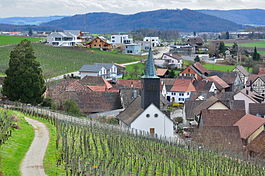Dörflingen
Dörflingen | |
|---|---|
 | |
| Coordinates: 47°42′N 8°43′E / 47.700°N 8.717°E | |
| Country | Switzerland |
| Canton | Schaffhausen |
| District | n.a. |
| Area | |
• Total | 5.82 km2 (2.25 sq mi) |
| Elevation | 451 m (1,480 ft) |
| Population (31 December 2018)[2] | |
• Total | 1,028 |
| • Density | 180/km2 (460/sq mi) |
| Time zone | UTC+01:00 (Central European Time) |
| • Summer (DST) | UTC+02:00 (Central European Summer Time) |
| Postal code(s) | 8239 |
| SFOS number | 2915 |
| ISO 3166 code | CH-SH |
| Surrounded by | Büsingen am Hochrhein (DE-BW), Diessenhofen (TG), Gailingen am Hochrhein (DE-BW), Gottmadingen (DE-BW), Schaffhausen, Thayngen |
| Website | doerflingen Profile (in German), SFSO statistics |
Dörflingen is a village and a municipality in the canton of Schaffhausen in Switzerland. It borders a short strip of the north shore of the Rhine.
History
[edit]Dörflingen is first mentioned in 1264 as Dorfelingen.[3]
Geography
[edit]

Dörflingen has an area, as of 2006[update], of 5.8 km2 (2.2 sq mi). Of this area, 64.3% is used for agricultural purposes, while 26.9% is forested. Of the rest of the land, 7.5% is settled (buildings or roads) and the remainder (1.4%) is non-productive (rivers or lakes).[4]
Dörflingen is located in the Reiat district, about 6 km (3.7 mi) east of Schaffhausen and has two separate international borders with Germany, one of which being with the German exclave of Büsingen am Hochrhein.
Economy
[edit]Dörflingen has an unemployment rate of 1.02%. As of 2005[update], there were 60 people employed in the primary economic sector and about 26 businesses involved in this sector. 68 people are employed in the secondary sector and there are 9 businesses in this sector. 56 people are employed in the tertiary sector, with 14 businesses in this sector.[4]
As of 2008[update] the mid year average unemployment rate was 1.3%. There were 22 non-agrarian businesses in the municipality and 64.2% of the (non-agrarian) population was involved in the secondary sector of the economy while 35.8% were involved in the third. At the same time, 72.4% of the working population was employed full-time, and 27.6% was employed part-time. There were 123 residents of the municipality who were employed in some capacity, of which females made up 26% of the workforce. As of 2000[update] there were 81 residents who worked in the municipality, while 319 residents worked outside Dörflingen and 41 people commuted into the municipality for work.[5]
As of 2008[update], there is 1 restaurant and the hospitality industry in Dörflingen employs 7 people.[5]
Demographics
[edit]Dörflingen has a population (as of 31 December 2020) of 1,010.[6] In 2008 a total of 11.6% of the population were foreign nationals. Of the foreign population, (as of 2008[update]), 53.2% are from Germany, 13.8% are from Italy, 1.1% are from Croatia, 1.1% are from Serbia, and 30.9% are from another country.[5] Over the last 10 years the population has grown at a rate of 3.9%. Most of the population (as of 2000[update]) speaks German (96.6%), with Italian being second most common (1.4%) and Serbo-Croatian being third (0.8%).[4]
The age distribution of the population (as of 2008[update]) is children and teenagers (0–19 years old) make up 22.7% of the population, while adults (20–64 years old) make up 62.9% and seniors (over 64 years old) make up 14.4%.[5]
In the 2007 federal election the most popular party was the SVP which received 42.9% of the vote. The next two most popular parties were the SP (28.7%), and the FDP (28.3%) .[4]
The entire Swiss population is generally well educated. In Dörflingen about 86.2% of the population (between age 25–64) have completed either non-mandatory upper secondary education or additional higher education (either university or a Fachhochschule).[4] In Dörflingen, as of 2007[update], 1.4% of the population attend kindergarten or another pre-school, 7.11% attend a Primary School, 4.82% attend a lower level Secondary School, and 3.17% attend a higher level Secondary School.[5]

As of 2000[update], 18.9% of the population belonged to the Roman Catholic Church and 61.7% belonged to the Swiss Reformed Church.[5]
The historical population is given in the following table:[3]
| year | population |
|---|---|
| 1689 | 396 |
| 1704 | 340 |
| 1850 | 560 |
| 1900 | 426 |
| 1930 | 418 |
| 1950 | 458 |
| 1990 | 582 |
| 2000 | 785 |
Sights
[edit]The village of Dörflingen is designated as part of the Inventory of Swiss Heritage Sites.[7]
Images
[edit]
References
[edit]- ^ a b "Arealstatistik Standard - Gemeinden nach 4 Hauptbereichen". Federal Statistical Office. Retrieved 13 January 2019.
- ^ "Ständige Wohnbevölkerung nach Staatsangehörigkeitskategorie Geschlecht und Gemeinde; Provisorische Jahresergebnisse; 2018". Federal Statistical Office. 9 April 2019. Retrieved 11 April 2019.
- ^ a b Dörflingen in German, French and Italian in the online Historical Dictionary of Switzerland.
- ^ a b c d e Swiss Federal Statistical Office Archived 5 January 2016 at the Wayback Machine. Retrieved 8 December 2009
- ^ a b c d e f Statistical Office of the Canton of Schaffhausen (in German). Retrieved 2 December 2009
- ^ "Ständige und nichtständige Wohnbevölkerung nach institutionellen Gliederungen, Geburtsort und Staatsangehörigkeit". bfs.admin.ch (in German). Swiss Federal Statistical Office - STAT-TAB. 31 December 2020. Retrieved 21 September 2021.
- ^ ISOS site. Retrieved 8 December 2009
External links
[edit]- Dörflingen in German, French and Italian in the online Historical Dictionary of Switzerland.






